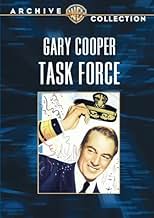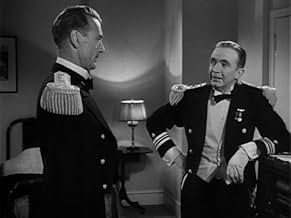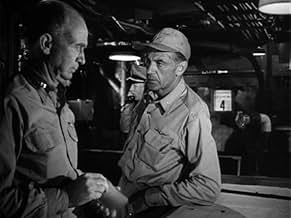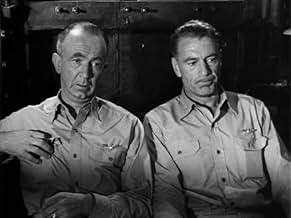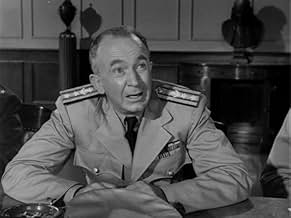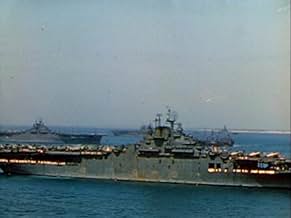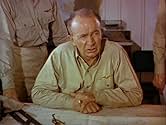Aggiungi una trama nella tua linguaAs he is retiring, Jonathan L. Scott "Scotty" reminisces about his long Navy career and the development of the role of the aircraft carrier from the early 20s.As he is retiring, Jonathan L. Scott "Scotty" reminisces about his long Navy career and the development of the role of the aircraft carrier from the early 20s.As he is retiring, Jonathan L. Scott "Scotty" reminisces about his long Navy career and the development of the role of the aircraft carrier from the early 20s.
- Premi
- 3 vittorie totali
- Pilot
- (non citato nei titoli originali)
- Pilot
- (non citato nei titoli originali)
- Pilot
- (non citato nei titoli originali)
- Ames' Attache
- (non citato nei titoli originali)
Recensioni in evidenza
Later, when WWII arrives, the film is much more of an action flick and gives a very competent overview of the war in the Pacific. While this did employ a lot of stock footage, it was unusual in that most all of the footage was used correctly. Unlike the ridiculously historically inaccurate film, MIDWAY (1976), TASK FORCE made sure to use clips that were accurate--featuring the correct model planes for each segment of the war (whereas in MIDWAY, they often showed planes that weren't even in the naval arsenal until well after the battle as well as had dive bombers magically turn into fighter planes in mid-flight due to horrid editing blunders).
This film really has widely different appeal depending on your perspective. If you are a history teacher and airplane nut like me, then it earns a 9 because it does a really good job of conveying the history of the American aircraft carriers from its inception in the early 1920s through WWII. However, if you are not, then you might find the film a bit cold (as it often focuses more on events than people towards the middle to the end of the film) and it might seem a bit confusing if you aren't familiar with the history of these great ships.
For all the history he witnessed, Scott had a rather tragic life. He wanted to be a pilot. But he gets sent to Washington, then to a desk job in Panama, then to Annapolis as an instructor, and then he is promoted to being an officer on a carrier in the Pacific when WWII begins. Seldom is he in the air himself. That's not the way the film sold it, but I did notice that aspect. Then there is Scott's personal life. He falls in love with Mary Morgan (Jane Wyatt), the widow of a pilot friend of his who died in a plane crash. The two develop feelings for each other fairly quickly, but don't do anything about them for over seven years. Mary says she does not want to marry a pilot again and always worry, and ironically the way Scott's life worked out she wouldn't have been marrying one even if she married Scott early on! And then after Scott actually DOES crash his plane THEN she decides to accept his proposal! Jane Wyatt seems a little homespun for the likes of Coop, but the two actors make it work.
There's lots of actual footage of WWII aerial battles, and you can tell real care went into detail so that this film looked authentic. For some reason, the film switches over to color about two thirds into it. That is where most of the action takes place, but it is rather an odd switchover, seeming somewhat like a holdover from the 1930s when individual scenes of a black and white movie would be shot in color.
Warner Brothers put their best supporting players into this film including Wayne Morris and Bruce Bennett, and there is Walter Brennan making his eighth and final appearance in a film with Gary Cooper. There's also a very early appearance by Julie London as the wife of one of the pilots. If you are interested in naval history this is an interesting way to spend a couple of hours.
For today's fans if one wants to see where Tom Cruise and the gang from Top Gun all got their start, take a look at Task Force. The idea of a floating flattop ship from where airplanes could take off and land was one that was scoffed at post World War I. Pilots didn't have the skills yet for that. What Task Force shows is Gary Cooper and a whole bunch of other people who believed in an idea living and dying to prove that idea.
Task Force was memorable in the career of Gary Cooper for two other reasons. It was the first film he did after leaving his original studio, Paramount, at Warner Brothers where he worked for about five years. It was also the last film he did with good friend Walter Brennan. They made eight joint film appearances, including some memorable ones in The Westerner and Sergeant York where they got Oscars, Brennan for The Westerner and Cooper for Sergeant York.
Jane Wyatt is Cooper's leading lady, playing the part of the faithful wife where if this had been made at MGM, June Allyson would have had the part. She's the widow of one of Cooper's early Navy flier friends who is killed trying to land on a new aircraft carrier.
Director Delmar Daves made good use of actual combat footage both black and white and in the last 15 minutes color. Lent a real air of authenticity to what we were viewing. Look for some good supporting performances from Brennan, Wayne Morris, Bruce Bennett and the best being an obtuse United States Senator played by Stanley Ridges.
The final shot of the film shows Cooper now in civilian attire with jets passing overhead. That was a whole new skill that had to be learned by the next generation of Top Guns. Very graphically demonstrated in The Bridges at Toko-Ri.
I'd like to think that Tom Cruise and the rest of the cast of Top Gun saw those two films and realized the great heritage they were now going to portray.
Lo sapevi?
- QuizWayne Morris who portrayed Lt.McKinney was the only actor in the cast who had actual combat experience as a carrier pilot in WWII. As a fighter pilot, Morris shot down seven enemy planes and contributed to the sinking of five enemy ships. He was awarded four Distinguished Flying Crosses and two Air Medals. He was the only combat "ace" of all the Hollywood actors who went to war.
- BlooperDuring the attack sequence on the Japanese carriers at Midway, the film shows the dive bombers striking first. Actually, it was the torpedo bombers that attacked first. This was caused by missed communications between the torpedo planes and the fighter cover. It was supposed to be a coordinated high-low attack. Almost every torpedo plane was shot down. No torpedoes made hits. While a tragic accident, the torpedo planes drew the Japanese fighter cover down to wave top height. When the U.S. fighters and dive bombers arrived there were very few Japanese fighters to intercept them.
- Citazioni
Pete Richard: The disarmament conference is over. They've sunk the fleet. The Missouri, the South Dakota, the Maine, the Virginia, Nebraska Georgia. 30 capital ships. More ships sunk with the stroke of a pen than have been sunk in our entire history.
- ConnessioniEdited from 7 dicembre (1943)
- Colonne sonoreTea for Two
(uncredited)
Music by Vincent Youmans
Played when Cmdr. Richard introduces Lt. Scott to the Admiral and his wife
I più visti
- How long is Task Force?Powered by Alexa
Dettagli
- Tempo di esecuzione
- 1h 56min(116 min)
- Colore
- Proporzioni
- 1.37 : 1


